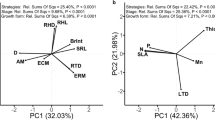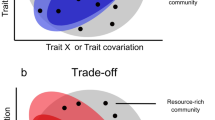Abstract
Background and aims
Water is the primary limiting factor for plants in drylands, which are projected to become even drier with climate change. Plant functional traits related to water influences individual performance, community composition, and can provide insight into which species will be most vulnerable to drought.
Methods
Here, we used a trait-based approach to examine key water-related traits of five perennial grasses of the Colorado Plateau, with the goals of identifying functional trait syndromes, and assessing vulnerability to drought. We examined 14 traits including hydraulic, above- and belowground biomass, and morphology, then assessed how these traits varied by species, and photosynthetic pathway.
Results
Individual water-related traits varied widely, but did not consistently vary by photosynthetic pathway. We identified three unique functional trait syndromes that could be classified as either conservative or non-conservative with regard to water use.
Conclusions
Variation in water-related traits may be key to the coexistence of species in drylands, but there is uncertainty as which traits or functional trait syndromes will be most vulnerable to changes in climate. Based on the traits examined here, and forecast changes in climate for the region, we predict that the cool-season, C3 grasses will be most vulnerable in this drying, more drought-prone region.




Similar content being viewed by others
References
Aschehoug ET, Brooker R, Atwater DZ et al (2016) The mechanisms and consequences of interspecific competition among plants. Annu Rev Ecol Evol Syst 47:263–281. https://doi.org/10.1146/annurev-ecolsys-121415-032123
Atkinson RRL, Burrell MM, Osborne CP et al (2012) A non-targeted metabolomics approach to quantifying differences in root storage between fast- and slow-growing plants. New Phytol 196:200–211. https://doi.org/10.1111/j.1469-8137.2012.04274.x
Bartlett MK, Scoffoni C, Ardy R et al (2012a) Rapid determination of comparative drought tolerance traits: using an osmometer to predict turgor loss point. Methods Ecol Evol 3:880–888. https://doi.org/10.1111/j.2041-210X.2012.00230.x
Bartlett MK, Scoffoni C, Sack L (2012b) The determinants of leaf turgor loss point and prediction of drought tolerance of species and biomes: a global meta-analysis. Ecol Lett 15:393–405. https://doi.org/10.1111/j.1461-0248.2012.01751.x
Brodribb TJ, Feild TS, Jordan GJ (2007) Leaf maximum photosynthetic rate and venation are linked by hydraulics. Plant Physiol 144:1890–1898. https://doi.org/10.1104/pp.107.101352
Brum M, Teodoro GS, Abrahão A, Oliveira RS (2017) Coordination of rooting depth and leaf hydraulic traits defines drought-related strategies in the Campos rupestres, a tropical montane biodiversity hotspot. Plant Soil 420:467–480. https://doi.org/10.1007/s11104-017-3330-x
Butterfield BJ, Bradford JB, Munson SM, Gremer JR (2017) Aridity increases below-ground niche breadth in grass communities. Plant Ecol 218:385–394. https://doi.org/10.1007/s11258-016-0696-4
Comstock JP, Ehleringer JR (1992) Plant adaptation in the Great Basin and Colorado plateau. Gt Basin Nat 52:195–215. https://doi.org/10.2307/41712719
Cook BI, Ault TR, Smerdon JE (2015) Unprecedented 21st century drought risk in the American southwest and Central Plains. Sci Adv 1:1–7
Crooks JL, Cascio WE, Percy MS et al (2016) The association between dust storms and daily non-accidental mortality in the United States, 1993-2005. Environ Health Perspect 124:1735–1743. https://doi.org/10.1289/EHP216
Fort F, Jouany C, Cruz P (2013) Root and leaf functional trait relations in Poaceae species: implications of differing resource-acquisition strategies. J Plant Ecol 6:211–219. https://doi.org/10.1093/jpe/rts034
Gleason SM, Blackman CJ, Chang Y et al (2016) Weak coordination among petiole, leaf, vein, and gas-exchange traits across Australian angiosperm species and its possible implications. Ecol Evol 6:267–278. https://doi.org/10.1002/ece3.1860
Gonzalez A, Loreau M (2009) The causes and consequences of compensatory dynamics in ecological communities. Annu Rev Ecol Evol Syst 40:393–414. https://doi.org/10.1146/annurev.ecolsys.39.110707.173349
Gremer JR, Bradford JB, Munson SM, Duniway MC (2015) Desert grassland responses to climate and soil moisture suggest divergent vulnerabilities across the southwestern United States. Glob Chang Biol 21:4049–4062. https://doi.org/10.1111/gcb.13043
Griffin-Nolan RJ, Bushey JA, Carroll CJW et al (2018) Trait selection and community weighting are key to understanding ecosystem responses to changing precipitation regimes. Funct Ecol 32:1746–1756. https://doi.org/10.1111/1365-2435.13135
Hoover DL, Knapp AK, Smith MD (2014) Resistance and resilience of a grassland ecosystem to climate extremes. Ecology 95:2646–2656. https://doi.org/10.1890/13-2186.1
Hoover DL, Duniway MC, Belnap J (2015) Pulse-drought atop press-drought: unexpected plant responses and implications for dryland ecosystems. Oecologia 179:1211–1221. https://doi.org/10.1007/s00442-015-3414-3
Hoover DL, Duniway MC, Belnap J (2017) Testing the apparent resistance of three dominant plants to chronic drought on the Colorado Plateau. J Ecol 105. https://doi.org/10.1111/1365-2745.12647
IPCC (2013) Climate change 2013: The physical science basis. Contribution of working group I to the fifth assessment report of the intergovernmental panel on climate change. Cambdridge University Press, Cambridge and New York
Kubiske ME, Abrams MD (1991) Oecologia in four temperate woody species : variability with site , time. Tree Physiol:537–542
Lloret F, Escudero A, Iriondo JM et al (2012) Extreme climatic events and vegetation: the role of stabilizing processes. Glob Chang Biol 18:797–805. https://doi.org/10.1111/j.1365-2486.2011.02624.x
Maestre FT, Eldridge DJ, Soliveres S et al (2016) Structure and functioning of dryland ecosystems in a changing world. Annu Rev Ecol Evol Syst 47:215–237. https://doi.org/10.1146/annurev-ecolsys-121415-032311
Manzoni S, Vico G, Katul G et al (2013) Hydraulic limits on maximum plant transpiration and the emergence of the safety-efficiency trade-off. New Phytol 198:169–178. https://doi.org/10.1111/nph.12126
Middleton NJ (2017) Desert dust hazards: a global review. Aeolian Res 24:53–63. https://doi.org/10.1016/j.aeolia.2016.12.001
Munson SM, Belnap J, Schelz CD et al (2011) On the brink of change: plant responses to climate on the Colorado plateau. Ecosphere 2:1–15. https://doi.org/10.1890/ES11-00059.1
Ocheltree TW, Nippert JB, Prasad PVV (2016) A safety vs efficiency trade-off identified in the hydraulic pathway of grass leaves is decoupled from photosynthesis, stomatal conductance and precipitation. New Phytol 210:97–107. https://doi.org/10.1111/nph.13781
Painter TH, Deems JS, Belnap J et al (2010) Response of Colorado River runoff to dust radiative forcing in snow. Proc Natl Acad Sci U S A 107:17125–17130. https://doi.org/10.1073/pnas.0913139107
Pearcy RW, Ehleringer J (1984) Comparative ecophysiology of C3 and C4 plants. Plant Cell Environ 7:1–13. https://doi.org/10.1111/j.1365-3040.1984.tb01194.x
Reich PB (2014) The world-wide “fast-slow” plant economics spectrum: a traits manifesto. J Ecol 102:275–301. https://doi.org/10.1111/1365-2745.12211
Safriel U, Adeel Z (2005) Ecosystems and human well-being: current state and trends, Chapter 22: Dryland Systems
Sage RF (2004) The evolution of C4 photosynthesis. New Phytol 161:341–370
Saxton K, Rawls W, Romberger J, Papendick R (1986) Estimating generalized soil-water characteristics from texture. Soil Sci Soc Am J 50:1031–1036
Schwinning S, Ehleringer JR (2001) Water use trade-off’s and optimal adaptations to pulse-driven arid ecosystems. J Ecol 89:464–480
Schwinning S, Belnap J, Bowling DR, Ehleringer JR (2008) Sensitivity of the Colorado plateau to change: climate, ecosystems. and society Ecol Soc 13:1–13
Seager R, Ting M, Held I et al (2007) Model projections of an imminent transition to a more arid climate in southwestern North America. Science, 316(80):1181–1184. https://doi.org/10.1126/science.1139601
Silvertown J, Araya Y, Gowing D (2015) Hydrological niches in terrestrial plant communities: a review. J Ecol 103:93–108. https://doi.org/10.1111/1365-2745.12332
Stampfli A, Bloor JMG, Fischer M, Zeiter M (2018) High land-use intensity exacerbates shifts in grassland vegetation composition after severe experimental drought. Glob Chang Biol 24:2021–2034. https://doi.org/10.1111/gcb.14046
Stuart-Haëntjens E, De Boeck HJ, Lemoine NP et al (2018) Mean annual precipitation predicts primary production resistance and resilience to extreme drought. Sci Total Environ 636:360–366. https://doi.org/10.1016/j.scitotenv.2018.04.290
Thoma DP, Munson SM, Witwicki DL (2018) Landscape pivot points and responses to water balance in national parks of the southwest U.S. J Appl Ecol. https://doi.org/10.1111/1365-2664.13250
USGCRP (2017) Climate science special report: fourth National Climate Assessment, volume. USA, Washington, DC, p I
Van Ruijven J, Berendse F (2010) Diversity enhances community recovery, but not resistance, after drought. J Ecol 98:81–86. https://doi.org/10.1111/j.1365-2745.2009.01603.x
Verheijen LM, Aerts R, Bönisch G et al (2016) Variation in trait trade-offs allows differentiation among predefined plant functional types: implications for predictive ecology. New Phytol 209:563–575. https://doi.org/10.1111/nph.13623
Witwicki DL, Munson SM, Thoma DP (2016) Effects of climate and water balance across grasslands of varying C3 and C4 grass cover. Ecosphere 7:1–19. https://doi.org/10.1002/ecs2.1577
Yang Z, Jiang L, Su F et al (2016) Nighttime warming enhances drought resistance of plant communities in a temperate steppe. Sci Rep 6:1–9. https://doi.org/10.1038/srep23267
Acknowledgements
We would like to thank the USGS technicians that helped collect the data for this experiment including Anna Knight, Jessica Mikenas, and Rose Egelhoff. DLH gratefully acknowledges the funding support from the USGS Climate and Land Use and Ecosystem Programs as well as the USDA-ARS. Any use of trade names is for descriptive purposes only and does not imply endorsement by the U.S. government.
Author information
Authors and Affiliations
Corresponding author
Additional information
Responsible Editor: Ian Dodd.
Publisher’s note
Springer Nature remains neutral with regard to jurisdictional claims in published maps and institutional affiliations.
Electronic supplementary material
ESM 1
(DOCX 14 kb)
Rights and permissions
About this article
Cite this article
Hoover, D.L., Koriakin, K., Albrigtsen, J. et al. Comparing water-related plant functional traits among dominant grasses of the Colorado Plateau: Implications for drought resistance. Plant Soil 441, 207–218 (2019). https://doi.org/10.1007/s11104-019-04107-9
Received:
Accepted:
Published:
Issue Date:
DOI: https://doi.org/10.1007/s11104-019-04107-9




